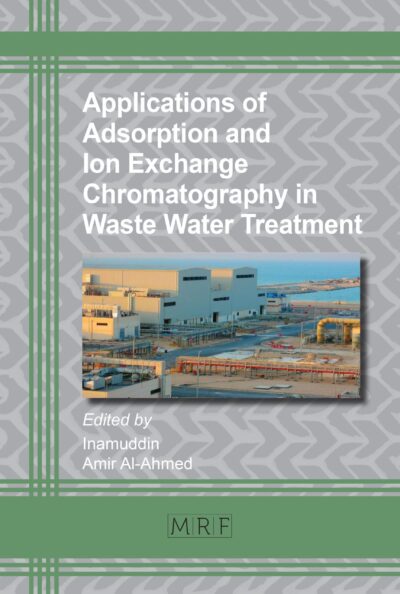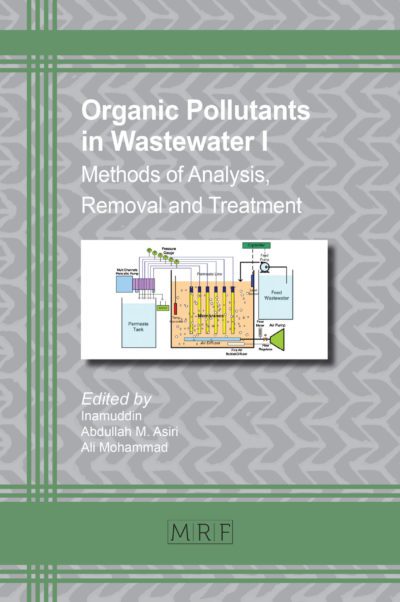Tailoring superparamagnetic nanoparticle for adsorption of carbon dioxide
NUR KAMALIYAH Dzil Razman, OH Pei Ching
Abstract. In recent years, green technologies have been extensively developed, including adsorption technology. In industrial installations, swing adsorptions are favoured for its continuous process. It also posed a large energy demands of almost 40% of overall energy supply. In a temperature swing adsorption (TSA) process, the purging or regeneration phase of the bed requires external heat, whether it to be from steam or hot gas, which largely contributed to the high demand. Hence, an extension of temperature swing adsorption was introduced to overcome the issue by using magnetize particles that can generate in-situ heat upon exposure to induction field. This study attempted to synthesize a magnetic nanoparticle that is superparamagnetic, to be embedded in metal organic framework (MOF). Superparamagnetic iron oxide (Fe3O4) was synthesised through one-pot solvothermal method using iron (III) chloride as its precursor at 250°C, for 10 hours. Synthesized Fe3O4 reported to have spherical shape from field emission scanning electron microscopy (FESEM), with crystalline size of 0.4 nm. Highest value of magnetic saturation was 50 emu/g, as obtained from vibrating sample magnetometry (VSM) test. From the VSM result, it was also firmed that superparamagnetic nanoparticles were achieved due to the absence of hysteresis loop and near zero retentivity of 0.11 emu/g. Parametric study on the reaction parameters and reactants concentration was also conducted. It was found that reaction temperature and concentration of sodium acetate able to reduce the particle size. Thus, with the result obtained, magnetite with high magnetic saturation and particle stability was tailored to be embedded with MOF to produce a magnetic framework composite.
Keywords
Magnetic, Superparamagnetic, Solvothermal Method, Nanoparticles, Adsorption
Published online 4/25/2025, 11 pages
Copyright © 2025 by the author(s)
Published under license by Materials Research Forum LLC., Millersville PA, USA
Citation: NUR KAMALIYAH Dzil Razman, OH Pei Ching, Tailoring superparamagnetic nanoparticle for adsorption of carbon dioxide, Materials Research Proceedings, Vol. 53, pp 433-443, 2025
DOI: https://doi.org/10.21741/9781644903575-44
The article was published as article 44 of the book Decarbonization Technology
![]() Content from this work may be used under the terms of the Creative Commons Attribution 3.0 license. Any further distribution of this work must maintain attribution to the author(s) and the title of the work, journal citation and DOI.
Content from this work may be used under the terms of the Creative Commons Attribution 3.0 license. Any further distribution of this work must maintain attribution to the author(s) and the title of the work, journal citation and DOI.
References
[1] A. Behera, S. S. Mohapatra, and D. K. Verma, “Nanomaterials: Fundamental Principle and Applications,” in Nanotechnology and Nanomaterial Applications in Food, Health, and Biomedical Sciences, Apple Academic Press, 2019, pp. 163–194. https://doi.org/10.1201/9780429425660-4.
[2] N. Barroso et al., “Magnetic sustentation as an adsorption characterization technique for paramagnetic metal-organic frameworks,” Commun Chem, vol. 6, no. 1, Dec. 2023. https://doi.org/10.1038/s42004-022-00799-w.
[3] X. M. Liu and J. K. Kim, “Solvothermal synthesis and magnetic properties of magnetite nanoplatelets,” Mater Lett, vol. 63, no. 3–4, pp. 428–430, Feb. 2009. https://doi.org/10.1016/j.matlet.2008.11.001.
[4] E. Oddo, R. M. Pesce, M. Derudi, and L. Magagnin, “Amino-functionalized magnetic nanoparticles for CO2 capture,” Int J Smart Nano Mater, vol. 12, no. 4, pp. 472–490, 2021. https://doi.org/10.1080/19475411.2021.1987350.
[5] L. S. Ganapathe, M. A. Mohamed, R. M. Yunus, and D. D. Berhanuddin, “Magnetite (Fe3O4) nanoparticles in biomedical application: From synthesis to surface functionalisation,” Magnetochemistry, vol. 6, no. 4. MDPI AG, pp. 1–35, Dec. 01, 2020. https://doi.org/10.3390/magnetochemistry6040068.
[6] J. S. T. Hernandez et al., “Characterization of Fe3O4 Nanoparticles for Applications in Catalytic Activity in the Adsorption/Degradation of Methylene Blue and Esterification,” Molecules, vol. 27, no. 24, Dec. 2022. https://doi.org/10.3390/molecules27248976.
[7] H. ; Pashaei, Ghaemi, and Ahad, “Review of CO2 Capture Using Absorption and Adsorption Technologies,” 2022.
[8] I. Castellanos-Rubio et al., “A Milestone in the Chemical Synthesis of Fe3O4 Nanoparticles: Unreported Bulklike Properties Lead to a Remarkable Magnetic Hyperthermia,” Chemistry of Materials, vol. 33, no. 22, pp. 8693–8704, Nov. 2021. https://doi.org/10.1021/acs.chemmater.1c02654.
[9] M. Karimi, M. Shirzad, J. A. C. Silva, and A. E. Rodrigues, “Carbon dioxide separation and capture by adsorption: a review,” Environmental Chemistry Letters, vol. 21, no. 4. Springer Science and Business Media Deutschland GmbH, pp. 2041–2084, Aug. 01, 2023. https://doi.org/10.1007/s10311-023-01589-z.
[10] D. Digitalcommons@umaine and N. Carter, “Physical Properties of Iron Oxide Nanoparticles,” 2015. [Online]. Available: https://digitalcommons.library.umaine.edu/honors
[11] M. Rukhsar, Z. Ahmad, A. Rauf, H. Zeb, M. Ur-Rehman, and H. A. Hemeg, “An Overview of Iron Oxide (Fe3O4) Nanoparticles: From Synthetic Strategies, Characterization to Antibacterial and Anticancer Applications,” Crystals, vol. 12, no. 12. MDPI, Dec. 01, 2022. https://doi.org/10.3390/cryst12121809.
[12] A. Włodarczyk, S. Gorgoń, A. Radoń, and K. Bajdak-Rusinek, “Magnetite Nanoparticles in Magnetic Hyperthermia and Cancer Therapies: Challenges and Perspectives,” Nanomaterials, vol. 12, no. 11. MDPI, Jun. 01, 2022. https://doi.org/10.3390/nano12111807.
[13] M. R. Ghazanfari, M. Kashefi, S. F. Shams, and M. R. Jaafari, “Perspective of Fe3O4 Nanoparticles Role in Biomedical Applications,” Biochemistry Research International, vol. 2016. Hindawi Limited, 2016. https://doi.org/10.1155/2016/7840161.
[14] A. E. Deatsch and B. A. Evans, “Heating efficiency in magnetic nanoparticle hyperthermia,” Journal of Magnetism and Magnetic Materials, vol. 354. pp. 163–172, 2014. https://doi.org/10.1016/j.jmmm.2013.11.006.
[15] S. Li et al., “Energy dissipation evaluation of temperature swing adsorption (TSA) cycle based on thermodynamic entropy insights,” Sci Rep, vol. 9, no. 1, Dec. 2019. https://doi.org/10.1038/s41598-019-53398-6.
[16] M. Gholami, B. Verougstraete, R. Vanoudenhoven, G. V. Baron, T. Van Assche, and J. F. M. Denayer, “Induction heating as an alternative electrified heating method for carbon capture process,” Chemical Engineering Journal, vol. 431, Mar. 2022. https://doi.org/10.1016/j.cej.2021.133380.
[17] A. Ali et al., “Synthesis, characterization, applications, and challenges of iron oxide nanoparticles,” Nanotechnology, Science and Applications, vol. 9. Dove Medical Press Ltd, pp. 49–67, Aug. 19, 2016. https://doi.org/10.2147/NSA.S99986.
[18] M. A. Mikhailova et al., “SUPPLEMENTARY INFORMATION Revisiting Syntheses of Fe 3 O 4 Nanoparticles in Water and Lower Alcohols for Memristive Application,” 2021.
[19] M. Pashangpour and A. A. Peyghan, “Adsorption of carbon monoxide on the pristine, B- and Al-doped C3N nanosheets,” J Mol Model, vol. 21, no. 5, Apr. 2015. https://doi.org/10.1007/s00894-015-2648-7.
[20] V. Phouthavong et al., “Magnetic Adsorbents for Wastewater Treatment: Advancements in Their Synthesis Methods,” Materials, vol. 15, no. 3. MDPI, Feb. 01, 2022. https://doi.org/10.3390/ma15031053.
[21] W. Lei et al., “Synthesis and magnetic properties of octahedral Fe3O4 via a one-pot hydrothermal route,” Physics Letters, Section A: General, Atomic and Solid State Physics, vol. 381, no. 4. Elsevier B.V., pp. 314–318, Jan. 30, 2017. https://doi.org/10.1016/j.physleta.2016.09.018.
[22] J. Liu et al., “Highly water-dispersible biocompatible magnetite particles with low cytotoxicity stabilized by citrate groups,” Angewandte Chemie – International Edition, vol. 48, no. 32, pp. 5875–5879, Jul. 2009. https://doi.org/10.1002/anie.200901566.
[23] J. Ren, Z. Zhu, Y. Qiu, F. Yu, J. Ma, and J. Zhao, “Magnetic field assisted adsorption of pollutants from an aqueous solution: A review,” Journal of Hazardous Materials, vol. 408. Elsevier B.V., Apr. 15, 2021. https://doi.org/10.1016/j.jhazmat.2020.124846.
[24] R. Azimikia, H. Mazaheri, A. H. Joshaghani, and E. Joudaki, “An experimental study of acid gas absorption by method hybrid nanofluid spraying in the presence of continuous and alternating magnetic fields,” Journal of Materials Research and Technology, vol. 13, pp. 919–932, Jul. 2021. https://doi.org/10.1016/j.jmrt.2021.05.013.
[25] P. Nanta, K. Kasemwong, and W. Skolpap, “Isotherm and kinetic modeling on superparamagnetic nanoparticles adsorption of polysaccharide,” J Environ Chem Eng, vol. 6, no. 1, pp. 794–802, Feb. 2018. https://doi.org/10.1016/j.jece.2017.12.063.
[26] M. D. Nguyen, H. V. Tran, S. Xu, and T. R. Lee, “Fe3O4 nanoparticles: Structures, synthesis, magnetic properties, surface functionalization, and emerging applications,” Applied Sciences (Switzerland), vol. 11, no. 23. MDPI, Dec. 01, 2021. https://doi.org/10.3390/app112311301.
[27] S. I. U. Madrid, U. Pal, and F. S.-D. Jesus, “Controlling size and magnetic properties of Fe3O4 clusters in solvothermal process,” Adv Nano Res, vol. 2, no. 4, pp. 187–198, Dec. 2014. https://doi.org/10.12989/anr.2014.2.4.187.
[28] M. Kalubowilage, K. Janik, and S. H. Bossmann, “Magnetic nanomaterials for magnetically-aided drug delivery and hyperthermia,” Applied Sciences (Switzerland), vol. 9, no. 14. MDPI AG, Jul. 01, 2019. https://doi.org/10.3390/app9142927.
[29] S. E. Favela-Camacho, E. J. Samaniego-Benítez, A. Godínez-García, L. M. Avilés- Arellano, and J. F. Pérez-Robles, “How to decrease the agglomeration of magnetite nanoparticles and increase their stability using surface properties,” Colloids Surf A Physicochem Eng Asp, vol. 574, pp. 29–35, Aug. 2019. https://doi.org/10.1016/j.colsurfa.2019.04.016.
[30] Y. V. Kolen’Ko et al., “Large-scale synthesis of colloidal Fe3O4 nanoparticles exhibiting high heating efficiency in magnetic hyperthermia,” Journal of Physical Chemistry C, vol. 118, no. 16, pp. 8691–8701, Apr. 2014. https://doi.org/10.1021/jp500816u.
[31] W. Li, J. Wu, S. S. Lee, and J. D. Fortner, “Surface tunable magnetic nano-sorbents for carbon dioxide sorption and separation,” Chemical Engineering Journal, vol. 313, pp. 1160–1167, 2017. https://doi.org/10.1016/j.cej.2016.11.013.
[32] Y. Wei, B. Han, X. Hu, Y. Lin, X. Wang, and X. Deng, “Synthesis of Fe3O4 nanoparticles and their magnetic properties,” in Procedia Engineering, Elsevier Ltd, 2012, pp. 632–637. https://doi.org/10.1016/j.proeng.2011.12.498.
[33] P. A. Ajibade, L. P. Mona, and S. P. Songca, “Effects of Reaction Temperature and Time on Structural, Morphological and Optical Properties of Magnetite Quantum Dots Prepared by Solvothermal Method,” J Inorg Organomet Polym Mater, 2023. https://doi.org/10.1007/s10904- 023-02841-3.
[34] G. C. Hermosa et al., “Investigations of the effective parameters on the synthesis of monodispersed magnetic Fe3O4 by solvothermal method for biomedical applications,” AIP Adv, vol. 10, no. 1, Jan. 2020. https://doi.org/10.1063/1.5130063.














